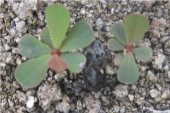Those who have never seen an infestation of tawny/Rasberry crazy ants have no idea what one is like. They form super colonies. Instead of each nest having its own guarded territory, effectively all of the ants recognize each other as sisters and work together. They can forage up to 1/4 to 1/2 mile for food. That means that every ant within a 1/4 to 1/2 mile radius can potentially converge on a given location. They are dense, typically over 100 times the concentration of typical ant species. They are aggressive combatants. You kill one, it releases alarm pheromones and ten take its place. Kill a thousand, ten thousand take their place. Kill a million, ten million take their place. This is just like a 1950s horror movie, except it is real.
To get a picture of what they can be like, here are a couple of video links:
1.
http://www.animalplanet.com/tv-shows/infested/videos/hairy-crazy-ant.htm is a documentary on Animal Planet of an infestation so bad that people walked away from their home in Mississippi because the problems were so severe and no effective treatments were available. The ants obsession with eating electrical insulation made staying in their home unsafe because of the potential of an electrical fire. Finally, they simple walked away from their home. This was after consulting with the leading ant specialist from Mississippi State University, who made/presented the documentary.
2.
documents a site in Tampa, Florida, that had piles and piles and piles of dead crazy ants all around the perimeter of their house. The accumulation shown was less than a week old. Sweeping these things up is a daily task and a nightmare. The treatment didn't slow them down. This video needs to be seen to be believed. More YouTube files show similar situations.
3. Tom Rasberry, who discovered the ants in Texas in 2002, talks about an experimental treatment on a 1/2 acre site near Houston, Texas, where he applied a particular insecticide and came back several months later. He found entire site was covered with a 2 inch thick layer of ants, a mixture of dead ants and living ants. This is 7,000 cubic feet of ant accumulation in 3 months on 1/2 acre. There were special circumstances, and most of the ants had probably traveled a long distance to come to the site. But, a few chickens or mushrooms or anteaters will not impact this kind of infestation. Again, until a person has seen an infestation like this in full bore, he has no comprehension of the problem. Unfortunately, this is reality and not horror fiction.
4. In Austin, Texas, I dropped a hot dog on the ground in an infested area and in less than 10 minutes there were six different established ant trails coming to it from different directions. These were all from different nests surrounding the hot dog.
Needless to say, property values can drop drastically for a site with a severe infestation.

























 Yea, incorporate and call yourself a fracking company. Then you can do whatever the hell you want and the EPA will ignore you.
Yea, incorporate and call yourself a fracking company. Then you can do whatever the hell you want and the EPA will ignore you.









































